
 Issue with Final Animation Position
Issue with Final Animation Position
I've had an issue for a while and thinking I must be doing something wrong as the root position and rotation seems to be off each time.
I have hand animations that I imported from another animation package. They look good, but I want to make new ones.
When I import them into UMotion, everything looks good. But when I export a clip (even if I didn't edit it), the root position and rotation seem to be off.
I'm currently using "Optimize Transform Hierarchy" in Unity and noticed the depending on whether is on or off, the positions seem to be different.
I could theoretically redo each animation and fix the positions, but there are a lot of them. So I want to see if there is a way to prevent this from happening? Maybe some option I have checked or unchecked in UMotion?

Hi,
thank you very much for your support request.
If your animation is of type humanoid you could try to let UMotion generate your root motion curve (instead of Unity) which helps in situations where Unity doesn't correctly generate the root motion curve:
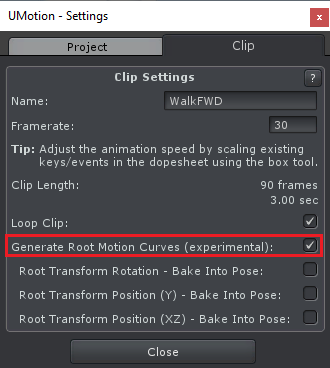
If your animation is of type generic it should always play exactly the same as the UMotion preview. If your animation is "generic" could you provide a small repo project including just everything I need to reproduce this on my PC and further investigate (this would be the UMotion project, the 3D model without textures if you want and the exported animation)? Please either use Unity's *.unitypackage format or create a new empty Unity project. Please use the email support form to send this to me (you can also request a link to my Dropbox via email if file size is too big).
Best regards,
Peter
 Porting over animations and gameobjects from Virtuanimator
Porting over animations and gameobjects from Virtuanimator
Hello, I am having troublles porting over thing from the faded away program Virtuanimator. Looks like I have an issue with bones. When porting them in your software mentions there are / slashes in file or missing hip bone or a list of things.
Could you suggest a program that can help repair this? Everything worked 4 years ago then UNITY updated the software and killed everything when upgrading ... I am glad you software is giving me some idea what it is

Hi,
thank you very much for your support request.
Are you using humanoid? Make sure that your character is setup correctly:
1) Select your character's source file in Unity's Project Window.
2) Select the "Rig" tab in the Inspector Window.
3) There should be no errors/warnings there. If there are some, try to address them.
4) Also click on "Configure..." and make sure that all bones are green and that the character is in T-pose.
If you need further assistant, please provide some additional information (screenshots, more detailed description of what you are trying to do step-by-step,...).
Best regards,
Peter
 New animation skeleton result
New animation skeleton result
Hi,
When creating a new animation with UMotion, using an existing animation as a “base”, which skeleton is the resulting animation mapped to?
is it mapped to the character you’re using or the skeleton from the animation you started with?
Basically, I’d like to us UMotion Editor to tweak and modify animations for a given skeleton and then export them out to use in other tools, but those other tools require the animation and model to share a skeleton.

Hi,
thank you very much for your support request.
If the animation you want to import/edit in UMotion is of type generic, then it has to use the same skeleton as the character that was used to setup the UMotion project. If you are working with humanoid, than you can import any other humanoid animation into UMotion.
When you export your animation from UMotion (using *.FBX), the *.FBX is going to use the skeleton of the character that was used in UMotion. 3D party modeling applications like Blender can then be used to edit that animation (on that specific character).
Quick Tip: When exporting to *.FBX I recommend to set "Write Mode" to "Update Existing File". This allows you to export your animation directly into the *.FBX of your character. This ensures best compatibility with Unity humanoid and also best compatibility with 3D party modeling applications.
Please let me know in case you have any follow-up questions.
Best regards,
Peter
 Discrepancy between Y Pos in edited animation and exported animation
Discrepancy between Y Pos in edited animation and exported animation
HI there, I'm practising with UMotion while trying to edit a timeline animation where a character jumps from the top of a building and hits the floor.
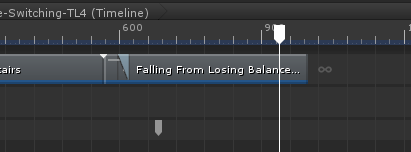
I particularly like the way UMotion can edit the animation in place/synch with the timeline etc.
The problem I've got is that the character falls way short of the ground (about 5 metres), so I've added an additive layer and moved the hips down so that the character hits the floor instead of landing above it (in thin air)
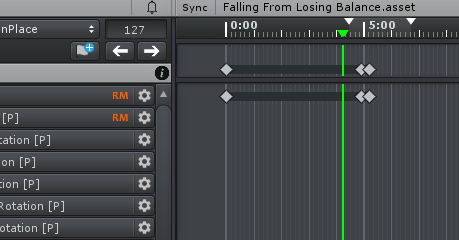
At the moment, the character needs a bit of fine-tuning, but he's basically on the ground!
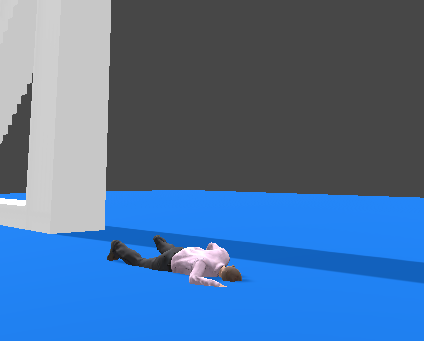
So, this is great, I export the animation (as an anim file) and check it out on the Unity Timeline. Everything looks good - the character is in the right position before making his jump, just as in the UMotion editor, he jumps......
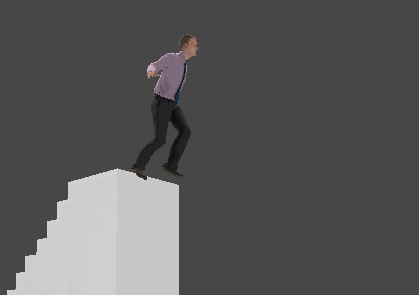
.....but lands about a foot off the floor - floating again, although not as far off as the original, so I know it's the animation I've exported.

Yet, if I reload the animation into UMotion again, it's fine. What am I doing wrong, or how I can get around this problem? Thanks in advance :)

Hi,
thank you very much for your support request.
When UMotion creates a *.anim file, Unity is still in charge of generating the root motion curves. Unity is doing that by using the UMotion generated *.anim and the Inspector settings you of the *.anim (like the one you posted in your screenshot above). Unity sometimes seems to not generate the root motion curves for humanoid animations correctly (I got this reported by several users in the past). That's why I've added a feature to let UMotion generate the root motion curves for you. You can enable that in the clip settings (in UMotion):
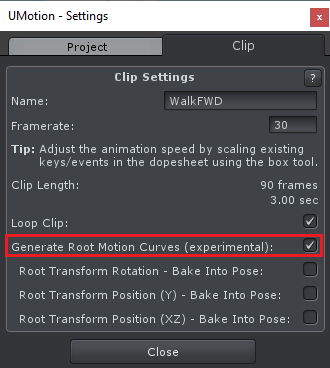
Please let me know if this solves your issue.
Best regards,
Peter
 Is there some way to automatically reduce/simplify/decimate key frames
Is there some way to automatically reduce/simplify/decimate key frames
Hi,
One of the tasks that I find ends up consuming the most time when I use UMotion Pro to clean up and edit mocap data is having to manually decimate and simplify key frames in areas that I need to edit so that the curves becomes practical to tweak and adjust.
I understand that UMotion Pro is resampling the whole animation via Unity's Humanoid model, (I'm also using UMotion Pro to convert a humanoid FK animation to IK) but is their perhaps some way to apply a more aggressive/lossy (ideally configurable error tolerance) key frame reduction after this resampling happens?
I can't find a way, but alternatively it could be good if there were some way to export a clip to fbx in such a way that the same fbx could then be re-loaded to replace the key frames of the original clip. I.e. instead of importing an fbx into a new clip, you could ask UMotion Pro to reload an fbx (that was previously exported) into an existing clip without any resampling. This way it would be possible to also edit the key frames in an external tool like Blender where I could decimate the key frames but then handle the rest of the clean up in UMotion Pro.
Any ideas for being able to decimate key frames after importing a new clip would be greatly appreciated,
Thanks!

Hi,
thank you very much for your support request.
Currently there is no decimate/simplify functionality in UMotion. But the *.FBX workflow you mentioned does indeed work. The trick is, to create a copy of your character that is configured as "generic". Create a new UMotion project for that characer and import your decimated animation (also configured as generic). You can use Unity's import settings to decimate or external tools like Blender. Generic animations are always imported "directly" without any re-sampling.
Please let me know if you have any follow-up questions.
Best regards,
Peter

 Where's the manual?
Where's the manual?
I've been googling and searching the site. I can find links.to videos, but no manual.
Whats the.URL for the manual?

Hi,
thank you very much for your support request.
There is no online version of the manual. If you've already purchased UMotion Pro or downloaded the free UMotion Community you can open the manual either via pressing [F1] in the Clip Editor or by opening the according *.html file in the UMotion Manual folder.
Please let me know in case you have any follow-up questions.
Best regards,
Peter

 How to rotate / translate the whole animation (all key frames) globally (additive layer not in global coordinates)
How to rotate / translate the whole animation (all key frames) globally (additive layer not in global coordinates)
Hi,
I have a number of motion capture animations that start with a T-Pose that's oriented in-line with one of the depth cameras used for motion capture, which determines the orientation of the global coordinates. These animations then include some exercise animations that are performed diagonally and offset from the origin, based on the location of an exercise mat, and maximising visibility from multiple cameras.
I have a number of these animations which I want to have a consistent origin and rotation that corresponds to the center of an exercise mat.
I've seen others asking similar questions and I have experimented with the possibility of using an additive layer or translating the x/y/z position key frames and converting the pelvis rotations to euler and translating the euler component key frames.
The problem with those options is that they are applying the rotations in the wrong coordinate space - the coordinates of the pelvis, but I'm simply trying to rotate everything in global coordinates.
I want to effectively rotate/translate the root bone, not add a local-coordinate rotation to the pelvis for every frame.
Currently I can manage the translation with an additive layer ok, but if I try and rotate everything then I end up tilting my whole animation instead of rotating everything in global/world coordinates.
This feels like it must be a common requirement to be able to rotate an animation to fixup its orientation so I'm hoping there's some trick I'm missing here?
Any help much appreciated!

Hi,
thank you very much for your support request.
Yes a rotation that is applied to the hips/pelvis does not rotate the translation of the hips/pelvis (that's due to the order how Unity applies those transformations).
The easiest way to rotate the whole animation is via the inspector of your animation:
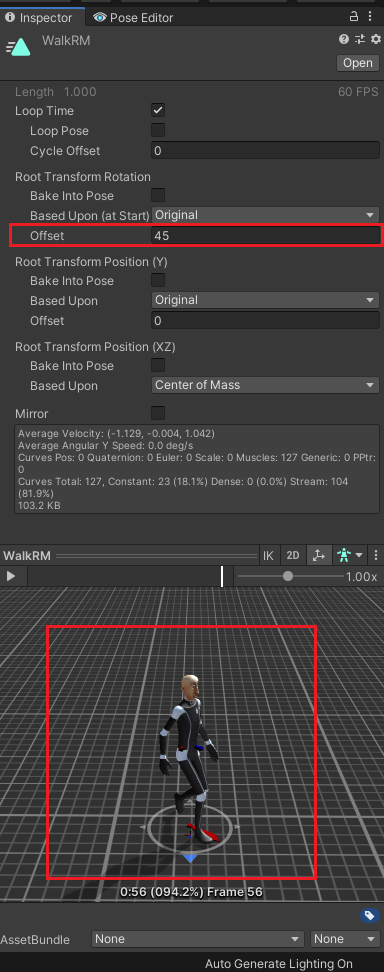
If you change this setting before you import the animation to UMotion, UMotion is going to bake the offset into the animation.
When exporting to *.FBX (from UMotion) you can also use the "Rotation Offset" shown in the "Export Settings". For further information, please refer to the manual (click on the question mark in the UI).
Please let me know if you have any follow-up questions.
Best regards,
Peter

 How to orbit camera around selected bone?
How to orbit camera around selected bone?
Perhaps this is me just being dumb, but because I can't technically select any bone in the hierarchy, only within the clip editor itself, I cannot focus the camera on a bone (shortcut: F). Thus I am not able to orbit my camera around easily to see what I am doing. This seems like basic functionality so I am most likely missing something but would appreciate some help if possible.

Hi,
thank you very much for your support request.
Bones should be select able using the left mouse button in the scene view when the character is assigned to the Pose Editor and the bone you are trying to select is not driven by IK (on the IK rig layer). If this doesn't work, there might be other assets that might be interfering with UMotion (this can happen if they consume all mouse click events in the Scene View even if they don't use them making it impossible for UMotion to get any mouse input). A user once kindly reported such an issue for an asset called "Multispector", I'm not sure if the developer of this asset fixed this already. Try using UMotion in a new empty Unity project to verify this.
To center the camera on a bone use the "Focus Camera" button in the Pose Editor or the corresponding "C" shortcut (the tooltip always shows the binded shortcut). To orbit the camera, hold "ALT" and the "Left Mouse Button" (default Unity camera control).
Please let me know in case you have any follow-up questions.
Best regards,
Peter

 Problem with custom transfer gizmo visibility
Problem with custom transfer gizmo visibility
Hi
I'm following the IK tutorial

but for some reason when I create the custom transfer it doesn't show the gizmo:
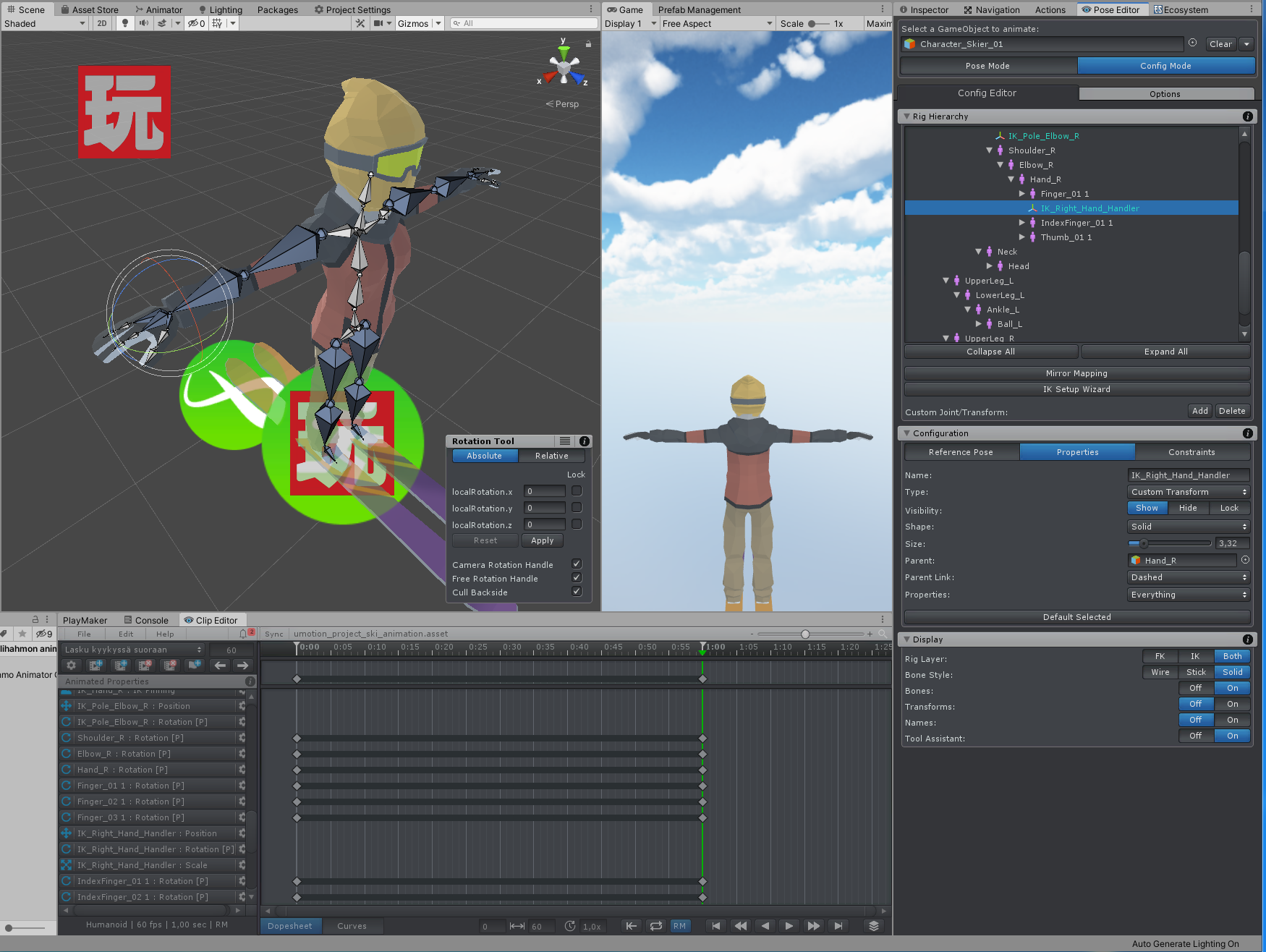
If I use custom joint I can see the sphere gizmo.
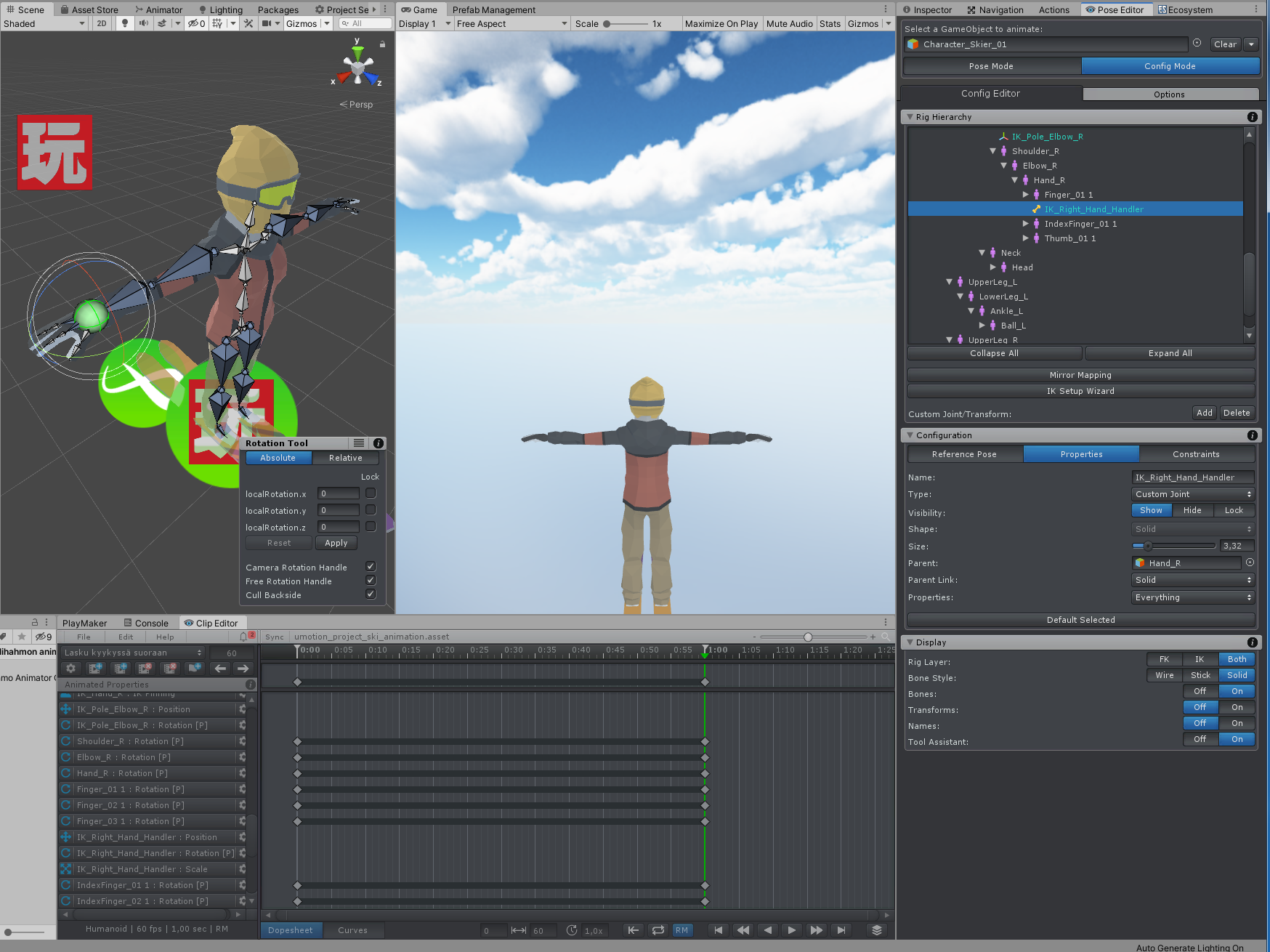
Is there something wrong with my setup or is this a bug?

Ok, glad to hear that everything is working now. If this issue happens again, please let me know.
Best regards,
Peter
 Workflow for Export to Blender?
Workflow for Export to Blender?
Hello everyone. I just bought the Pro version. In the Unity Asset Store, it lists one of the Pro Features as NEW: FBX Export (Windows and Mac OSX only) .... use animations created in UMotion in 3D modeling applications. I have followed the steps in the tutorial video for exporting an FBX, but I am running into problems when trying to import the FBX into Blender. Namely, some frames of the animation are dropped (24 in UMotion to 21 in Blender), and there are no bones or mesh included in the FBX. Only a hierarchy of empties. So my question is, has anyone successfully exported animations to Blender? If so, what steps did you take? Thanks for any assistance.

Hi,
thank you very much for your support request.
To export with mesh data, you need to export the animation into the *.FBX file that contains the mesh. You can do that by setting "Write Mode" to "Update Existing File" in the UMotion export settings. Then choose the *.FBX file that contains your character(mesh) as destination. Make sure to backup your *.FBX before you export (just to be on the safe side).
UMotion changes the frame rate of the *.FBX to the same frame rate that you've used in your animation (in UMotion). If Blender can only deal with 21 fps, you might want to change the frame rate to 21 fps in UMotion.
Please let me know in case you have any follow-up questions.
Best regards,
Peter
Customer support service by UserEcho
